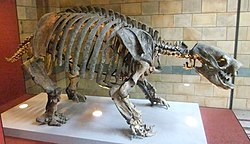Glossotherium
|
Glossotherium Temporal range: Late Pliocene to Early Holocene, 2.5–0.010 Ma |
|
|---|---|
 |
|
| Skeleton in Natural History Museum, London | |
| Scientific classification | |
| Kingdom: | Animalia |
| Phylum: | Chordata |
| Class: | Mammalia |
| Order: | Xenarthra |
| Family: | †Mylodontidae |
| Subfamily: | †Lestodontinae |
| Tribe: | †Glossotheriini |
| Genus: |
Glossotherium Owen, 1840 |
| Species | |
|
|
Glossotherium (literally "Tongue Beast") was a genus of ground sloth. It was a heavily built animal with a length of about 4 metres (13 ft) snout to tail-tip, a weight estimated at 1002.6 kg (2210.4 lb), and could potentially assume a slight bipedal stance.
Sloths are grouped into three categories: mylodontids, megalonychids, and megatheriids. Glossotherium belongs to the Mylodontidae, in which it is further subcategorized into the Mylodontinae, characterized both by the loss of the entepicondylar foramen of the distal humerus and anteriorly broad snouts.
Mylodontinae has five genera: Lestodon, Thinobadistes, Mylodon, Paramylodon, and Glossotherium. The latter three have frequently been confused for each other in scientific literature, though it is likely Paramylodon and Glossotherium share a more recent common ancestor than with any other mylodontid.Paramylodon is typically larger than Glossotherium, even though there is overlap in their size ranges, and Glossotherium is generally wider and more robust with a diagnostic increased amount of lateral flare at the predental spout.
Glossotherium robustum was endemic to South America and weighed about 1500 kg. records indicate that it was widely distributed between 20⁰S and 40⁰S, with a range spanning across Argentina, Brazil, Bolivia, Chile, Uruguay, and Paraguay.
Sloths have an ever-growing adult dentition. They lack deciduous dentition and have a reduction in tooth number. Sloth teeth also lack the enamel and cuspation pattern generally present in other mammals. Their tooth forms are oval, subrectangular, or elongate irregular ovoid with chisel-shaped “caniniform” teeth anteriorly and “molariform” cheek teeth. Glossotherium has a layer of cementum surrounding all molariform cheek teeth with some traces on caniniform teeth. Cheek teeth in Glossotherium are larger, have more complex shapes, and retain more of the cementum layer around all sides of each tooth than the Shasta ground sloth, Nothrotheriops shastensis, and tree sloths.
...
Wikipedia
